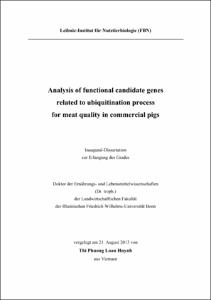Huynh, Thi Phuong Loan: Analysis of functional candidate genes related to ubiquitination process for meat quality in commercial pigs. - Bonn, 2014. - Dissertation, Rheinische Friedrich-Wilhelms-Universität Bonn.
Online-Ausgabe in bonndoc: https://nbn-resolving.org/urn:nbn:de:hbz:5n-35009
Online-Ausgabe in bonndoc: https://nbn-resolving.org/urn:nbn:de:hbz:5n-35009
@phdthesis{handle:20.500.11811/5828,
urn: https://nbn-resolving.org/urn:nbn:de:hbz:5n-35009,
author = {{Thi Phuong Loan Huynh}},
title = {Analysis of functional candidate genes related to ubiquitination process for meat quality in commercial pigs},
school = {Rheinische Friedrich-Wilhelms-Universität Bonn},
year = 2014,
month = mar,
note = {During the conversion from muscle to meat, the degradation of myofibrillar proteins impacts on the water holding capacity of meat. Besides the calpain/calpastatin proteolytic system, the activity of ubiquitin proteasome system also causes the degradation of intermediate filament proteins and integrins that leads to an increase of drip loss formation in the muscle cells. The current study sought to evaluate the effects on meat quality of the four functional candidate genes, UBXN1, UBE3B, TRIP12 and ZRANB1, that related to the ubiquitination processes. Nine novel polymorphisms were identified in the transcribed and 3´-UTR regions of these genes. Seven of these novel SNPs were genotyped in a total of about 570 animals derived from the two populations, German Landrace (GL) and the commercial crossbreed of Pietrain × (German Large White × German Landrace) (PiF1). The SNPs of the four candidate genes exhibited strong associations with the indicators of water holding capacity, including muscle conductivity (UBXN1, UBE3B, TRIP12); drip loss (UBXN1, UBE3B), pH values (UBXN1, TRIP12 and ZRANB1) and meat redness (UBE3B). The SNPs of the four candidate genes had also significant association with carcass traits such as loin eye area, loin fat depth and meat to fat ratio. Moreover, the variation of transcript abundances of UBXN1, ZRANB1 and TRIP12 were significantly associated with the respective polymorphisms. At the same time, their transcript abundances were correlated with muscle conductivity, pH and drip loss, respectively. UBE3B transcript abundance was associated with meat redness. The integration of association and expression data imply the existence of causal polymorphisms in the cis-regulatory regions of these candidate genes, which are in incomplete linkage disequilibrium with the detected SNPs, and which primarily affect their transcript abundance and, in consequence, traits related to water holding capacity. Thus the study revealed the consistent triangular relationship among genotype - phenotype - transcript abundance across the four candidate genes. In fact, the detected SNPs were in linkage phase with alleles of causal sites increasing the transcript abundances, and enhancing the purge loss in the case of UBXN1 and UBE3B, whereas decreasing drip loss formation in the case of TRIP12 and ZRANB1 genes. Moreover, interactions observed among these genes of the ubiquitination system and the ryanodine 1 receptor (RYR1) indicate options for further improvement of meat quality, in particular in RYR1 heterozygous animals, by considering genotypes at these loci. The results of this study provide genetic evidences to support UBXN1, UBE3B, TRIP12 and ZRANB1 as the functional candidate genes for water holding capacity of pork.},
url = {https://hdl.handle.net/20.500.11811/5828}
}
urn: https://nbn-resolving.org/urn:nbn:de:hbz:5n-35009,
author = {{Thi Phuong Loan Huynh}},
title = {Analysis of functional candidate genes related to ubiquitination process for meat quality in commercial pigs},
school = {Rheinische Friedrich-Wilhelms-Universität Bonn},
year = 2014,
month = mar,
note = {During the conversion from muscle to meat, the degradation of myofibrillar proteins impacts on the water holding capacity of meat. Besides the calpain/calpastatin proteolytic system, the activity of ubiquitin proteasome system also causes the degradation of intermediate filament proteins and integrins that leads to an increase of drip loss formation in the muscle cells. The current study sought to evaluate the effects on meat quality of the four functional candidate genes, UBXN1, UBE3B, TRIP12 and ZRANB1, that related to the ubiquitination processes. Nine novel polymorphisms were identified in the transcribed and 3´-UTR regions of these genes. Seven of these novel SNPs were genotyped in a total of about 570 animals derived from the two populations, German Landrace (GL) and the commercial crossbreed of Pietrain × (German Large White × German Landrace) (PiF1). The SNPs of the four candidate genes exhibited strong associations with the indicators of water holding capacity, including muscle conductivity (UBXN1, UBE3B, TRIP12); drip loss (UBXN1, UBE3B), pH values (UBXN1, TRIP12 and ZRANB1) and meat redness (UBE3B). The SNPs of the four candidate genes had also significant association with carcass traits such as loin eye area, loin fat depth and meat to fat ratio. Moreover, the variation of transcript abundances of UBXN1, ZRANB1 and TRIP12 were significantly associated with the respective polymorphisms. At the same time, their transcript abundances were correlated with muscle conductivity, pH and drip loss, respectively. UBE3B transcript abundance was associated with meat redness. The integration of association and expression data imply the existence of causal polymorphisms in the cis-regulatory regions of these candidate genes, which are in incomplete linkage disequilibrium with the detected SNPs, and which primarily affect their transcript abundance and, in consequence, traits related to water holding capacity. Thus the study revealed the consistent triangular relationship among genotype - phenotype - transcript abundance across the four candidate genes. In fact, the detected SNPs were in linkage phase with alleles of causal sites increasing the transcript abundances, and enhancing the purge loss in the case of UBXN1 and UBE3B, whereas decreasing drip loss formation in the case of TRIP12 and ZRANB1 genes. Moreover, interactions observed among these genes of the ubiquitination system and the ryanodine 1 receptor (RYR1) indicate options for further improvement of meat quality, in particular in RYR1 heterozygous animals, by considering genotypes at these loci. The results of this study provide genetic evidences to support UBXN1, UBE3B, TRIP12 and ZRANB1 as the functional candidate genes for water holding capacity of pork.},
url = {https://hdl.handle.net/20.500.11811/5828}
}






